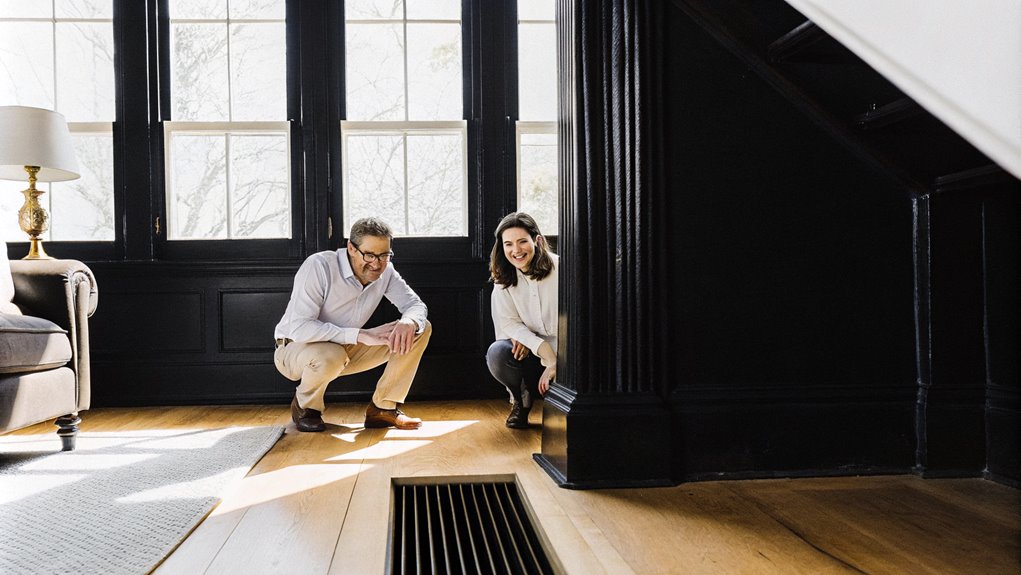Old wood floors that squeak aren't just part of your home's past – they can make your home worth more money. These floors are special because they came from trees that grew long ago. The wood has tiny lines close together, and skilled workers made them with great care. No one can make floors like these today.
You can fix the squeaks and make your floors quiet again. It costs between $200 and $5,000 to fix them up. When you do, you keep the floor's old beauty and make your home worth more.
If your home is very old, you might get help paying for the fixes. The government can give you money back through special programs. They might pay up to half of what it costs to fix the floors.
When you take care of these old floors, you're not just making them better – you're making your whole home more valuable.
Ready to start building equity in your own Michigan home? Get your personalized home loan quote today.
Key Takeaways
Old floors that creak can make your house worth more money. You can get money back – up to half of what you spend to fix them!
These old wooden floors came from big, old trees. They are special and worth a lot in old houses.
When floors make noise, get an expert to look at them. This stops bigger problems and keeps your house in good shape.
Old wood floors help keep your house warm in winter and cool in summer. This means you pay less for heating and cooling.
Take good care of your old floors. Keep them clean and fix them the right way. When you sell your house, good floors will help you get more money.
Michigan residents, unlock the door to your new home. Request your home loan quote from Treeside Financial today.
The True Cost of Squeaky Floors

Your old home might make squeaky noises when you walk on the floors. These sounds can tell you something is wrong under your feet. The wood parts that hold up your floor might be loose or old.
When floors get noisy, they need to be fixed. Small fixes can cost as little as $200. Big fixes can cost more than $5,000.
But fixing squeaky floors helps your home sell for more money later. People who want to buy your house don't like squeaky floors. They think it means bigger problems.
If you wait too long to fix the squeaks, things can get worse. Fix the floors now to keep your home strong and worth more money.
Historical Value of Original Hardwoods
When you walk on old hardwood floors in historic homes, you feel their special beauty.
You might be closer to buying your home than you think
Take our 2-minute home buyer readiness quiz to see how prepared you really are – no credit check required.

These floors tell stories through their scratches and marks from many years of use. The wood has rich colors that new floors can't copy.
Long ago, skilled workers made these floors by hand. They created pretty patterns and designs in the wood.
These old floors help keep historic homes true to their time, whether they were built in the 1800s or 1950s.
Each scratch and dent shows how families lived in these homes over many years.
Character Through Natural Aging
Your old wood floors tell special stories. People walking on them for many years have made soft marks. These marks show where families walked day after day. Each mark is like a tiny piece of history.
Look at the wood up close. Time has made the colors deeper and more beautiful. New floors don't look this way.
Near doors and windows, you can see where many feet have walked. Each room has its own path worn into it.
Even the little scratches make your floor special. No new floor can have this much history.
Original Craftsmanship Details
Old floors tell us stories about the people who made them. These skilled workers used special ways to put the floors together. They chose the best wood from old trees, like pine and oak. The wood had beautiful patterns you can't find today.
Look at the floors up close. You can see marks from hand tools and how the pieces fit snugly together. The wooden boards are bigger and longer than what we use now. They came from trees that grew for many years, making the wood strong.
The care these workers put into making these floors makes your home worth more today. Each mark and joint shows how much they knew about working with wood.
Architectural Period Authenticity
Old homes have special wooden floors that tell us stories about when they were built. In houses from long ago, you'll see thin wood boards made of oak or pine. In other old homes, you'll spot wide oak boards that show off their pretty grain.
Looking at your floors can help you know when your house was made. Before 1900, floors were often pine or chestnut wood. In the 1920s, builders used red oak a lot. You can also look at marks on the wood. Round marks mean the wood is very old. Straight marks mean the wood is a bit newer.
Taking care of these old floors is important. They're like time machines that show us how people lived before. When you keep them nice, they make your house worth more money too.
Common Causes of Floor Noise

Your old home's floor might make funny noises when you walk on it. These creaks and squeaks happen when parts under the floor get loose.
Think of your floor like a puzzle – it has wooden beams that hold it up. When these beams get old, they can pull away from the floor above them. This makes small gaps. When you step on these spots, they move and make noise.
Also, the wood in your house gets very dry as it ages. When wood dries out, it gets smaller. This makes the pieces move against each other, and that's why you hear those squeaky sounds when you walk.
Loose Joists and Subflooring
Your home's floors can get noisy and squeaky as they get old. This happens when parts under the floor come loose. The main parts are wooden beams called joists and the flat wood layer on top called subflooring. When these parts pull away from each other, you hear squeaks when you walk.
You can find loose spots by looking under your floor from the basement. Look for gaps between the beams and the wood floor above them. These gaps show up most in the middle of beams. They also happen when hot, wet summer air makes wood swell up, and dry winter air makes it shrink.
Sometimes, the nails that hold things together get loose and need to be fixed or changed.
Dried Wooden Support Structures
Your floors squeak because the wood inside them gets too dry. Think of wood like a sponge – when it dries out, it gets smaller. This happens a lot in older homes built before 1980. Back then, builders used wetter wood.
When wood dries up, it causes problems. The nails get loose. The big wood beams pull apart. Some pieces of wood even twist into funny shapes.
You'll hear more squeaks near warm spots in your house, like heating vents. These warm areas make the wood dry out faster.
Professional Assessment Vs DIY Inspection
Your home needs a checkup just like you do. Let's talk about who should do it.
You can look at your home yourself or get help from an expert. Both ways can work.
An expert home inspector is like a doctor for houses. They've special tools and know what to look for. They write down everything they find. This helps when you want to sell your home or fix it up.
You can look at your home too. Walk around and check for wet spots. See if the floor feels funny when you walk. Look for big cracks in the walls. Take lots of pictures of what you see.
The best plan might be to do both. Look at your home first. Then ask an expert to check it too. They can find things you mightn't see.
Signs of Hidden Floor Damage

Your floors can tell you when something's wrong if you know what to look for. Watch out for these signs:
- Floors that aren't flat
- Floors that make squeaky sounds
- Soft spots that sink when you step on them
- Space between your walls and floors
- Floors that sag down in the middle
When you walk on your floors, they should feel firm. If they feel bouncy like a trampoline, the wood under your floor might be weak.
Here's what to measure:
- The floor shouldn't slope more than 1 inch across 20 feet
- Look for gaps wider than 1/4 inch between the floor and wall
- Check for dips deeper than 1/2 inch
- Press on the floor – it shouldn't move more than 1/8 inch
If you see these problems, get help fast. Water, bugs, and house settling can make floor damage worse. This can hurt your whole house over time.
Preserving Vintage Wood Characteristics
Looking after old wood is special. The wood in old homes has beauty we can't get anymore. It comes from trees that grew long ago in forests we now protect.
When you work with old wood, be gentle. Don't sand it too much or you'll wipe away its story. To clean it, mix some oils and wipe them on softly. This helps dry spots look better.
If the wood is loose, use strong glue to make it firm. Put on natural oils to keep it safe.
When you need to fix parts, try to find old wood that looks the same. You can take it from other spots in your house or look for wood saved from old buildings.
Modern Repair Techniques

We love fixing old homes in new ways that keep their special history alive.
Today, we mix old-time skills with new tools to make repairs better than ever.
Here's how we fix old homes today:
- We use strong glue made of two parts to fix weak wood.
- We put special foam under floors to make them strong again.
- We add thin black strips to help hold up old beams.
- We put in tools that tell us when water might hurt the house.
These new ways help keep old homes looking just like they did long ago.
The fixes we do now will help the house stay strong for many years.
Your old home can keep its charm while staying safe and solid for your family.
Market Value of Restored Flooring
If you fix up your old wood floors, your home will be worth more money. People love real wood floors, especially in old houses. When you sell your home, you can get back most of the money you spent on fixing the floors.
Old wood floors from 100 years ago are very special. The trees they came from don't grow anymore. If you keep the floors looking like they did long ago, buyers will want to pay more for your home. Your house might sell much faster too, because people really want these old floors.
You can make your home worth more just by taking good care of these floors. In old parts of town, a home with nice old floors can be worth much more than one with new floors.
Choosing the Right Wood Treatment

Wood needs good care to stay beautiful. Think of wood like your skin – it needs protection.
You can pick from two kinds of treatments. One soaks deep into the wood. The other sits on top like a shield. Many people like to use oil-based coatings. These make the wood's pretty patterns stand out. They also keep water from hurting the wood.
To make your wood look nice for a long time, use stains that block sun damage. This helps the wood keep its color for many years to come.
Sealants for Antique Floors
Protecting old wood floors is like giving them a shield against water and damage. After many years of people walking on them, these floors can lose their protective coat.
You want to pick the right shield for your old floors. Here are the best ways to protect them:
- Oil shield (polyurethane): This soaks deep into the wood and makes it glow with a warm, honey color.
- Water shield (polyurethane): This makes a clear coat that won't turn yellow. It dries fast and doesn't smell much.
- Tung oil: This makes the wood look natural. You can fix small spots if they get damaged.
- Shellac: This works best on very old floors from before 1850. It looks just like the original coat did.
The shield you pick will change how your floor looks and how long it lasts.
Stains That Last Decades
Your wood stain can last a long time if you do three things right.
First, pick a special oil stain that fights sun damage.
Next, get the wood ready.
Last, put the stain on the right way.
Good stains soak deep into the wood to make it strong.
Before you start, sand the wood until it's smooth and clean off all the dust.
Make sure the wood isn't too wet or too dry.
When you put on the stain, use a soft brush.
Move the brush the same way the wood lines go.
Let each coat dry before you add more.
Many people find that using three thin coats works better than one thick coat.
If you do it this way, your stain can look good for up to 40 years with little care.
Structural Support Solutions
Your old home needs help staying strong. Just like your body needs a good backbone, your home needs strong supports to stand tall.
Think of your home like building blocks. The bottom blocks must be strong to hold up the ones on top. Before you make your home pretty, you need to fix what holds it up.
Here's what can help your home stay strong:
- Put in steel beams where old wood beams are weak. This helps spread the weight better.
- Add new wood beams next to old ones. This makes your floors stronger and stops them from making noise.
- Put strong straps on your walls to keep them from cracking.
- Add more posts under your house to help hold up your floors.
These fixes will help your home stand tall for many more years to come.
Historic Home Certification Benefits

When you get your old home certified as historic, you can save lots of money. The government will help pay for fixing up your home. You can get back up to 45 cents for every dollar you spend on repairs.
Getting your home listed as historic means it has a special story to tell. You can also get money from groups that want to save old homes.
Your home will be worth more money too – about 5-10% more than other old homes that aren't certified. This makes getting your home certified a smart choice.
Tax Credits and Savings
Owning a historic home can save you money on taxes. It's like getting a reward for taking care of an old house.
You can save money in these ways:
- Get back 20% of what you spend if you use the house to make money.
- Your state may give you 10% to 30% back when you fix up the house.
- Pay less in property taxes for up to 10 years.
- Save money by promising to keep the house historic forever.
You can also get money back for making your home use less energy. Many cities give out free money to fix old houses too.
All these savings can add up to thousands of dollars, which makes buying an old house cost less than you think.
Heritage Registry Distinction
When you put your old home on a heritage list, you get more than just money. You become part of a special group of people who care for old houses. You also get help from experts who know how to fix up old homes.
| What You Get | Town List | Country List |
|---|---|---|
| Home Value | Goes up 5-10% | Goes up 15-20% |
| Papers | Basic info | Full history |
| Help | From your town | From the country |
Once your home is on the list, you can go to special classes about fixing old houses. You can talk to people who know how to fix them right. You get nice signs to put on your house that show it is special. This makes your house worth more and helps keep it nice for many years. Your town will also help make sure no one changes the parts that make your house special.
Property Value Enhancement
Getting your old home certified as historic helps you make more money in three big ways. You can get money back on taxes, special money to fix up your home, and better loans from banks.
Your old home becomes more special when:
- You get back 20 cents for every dollar you spend fixing it up.
- Your property taxes stay the same for 10 years or more.
- You can get free money between $5,000 and $50,000 to keep your home nice.
- When you sell, you get more money than if you'd a regular old house.
Making your home historic is a good way to make it worth more money. You help save a piece of history, and your house becomes more valuable when people know it's special.
Floor Maintenance Through the Seasons
Your wood floors are like a living part of your home. They change with the seasons, just like we do. To keep them happy, watch how much water is in the air. Think of it like this – you want the air to be not too wet and not too dry.
In winter, the cold air makes your floors dry. Use a machine that adds water to the air to help them. When summer comes, use your AC to keep the floors from getting too wet.
Look at your floors every few months. Fix small marks with wood filler that matches your floor color.
Want to check if your floors need help? Drop some water on them. If the water sits on top like tiny balls, your floor is safe. If the water goes into the wood, your floor needs a new coat to protect it.
Clean your floors in ways that work for each season. Hot days need different care than cold days.
Buyer Appeal and Selling Points

Old homes have special things that make people fall in love with them. When you want to sell your old house, show off what makes it one of a kind.
- The fancy wood trim and wall details were made by hand long ago. Today, this kind of work costs too much for most new homes.
- The wood floors come from big, old trees we can't get anymore. The wood has tight lines that make it strong and pretty.
- Old streets have big trees and yards. The houses sit far apart. People know their neighbors well.
- Old homes have tall rooms and big windows. The thick walls help keep the house warm in winter and cool in summer.
Energy Efficiency and Old Floors
Old homes have special wood floors that help keep you warm in winter and cool in summer. These floors are made from trees that grew for a very long time. The wood is strong and thick.
The floors work like a blanket for your house. When the sun warms them up, they hold onto the heat. Later, when it gets cold, they let the heat out slowly. This helps you save money on heating and cooling your home.
You can make your old floors work even better. Fix any gaps between the wood boards. Make sure the space under the floor has good insulation too.
The people who built these homes knew how to lay the floors in ways that would keep houses cozy.
Financing Your Floor Restoration

Need money to fix your old wood floors? Don't worry – there are many ways to pay for it.
Let's look at how you can get help.
You can:
- Use your home's value to get a loan from the bank
- Look for special money from groups that want to save old homes
- Get money back on your taxes when you fix up historic houses
- Ask banks that like helping people fix old homes for a loan
Keep all your bills and papers that show the work you did.
You'll need these to get help paying for your floors.
Remember, fixing your floors will make your home look better and be worth more.
Take time to find the best way to pay for it.








